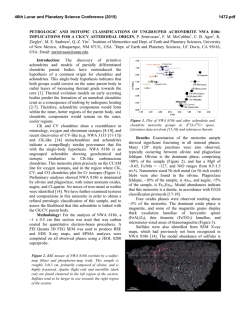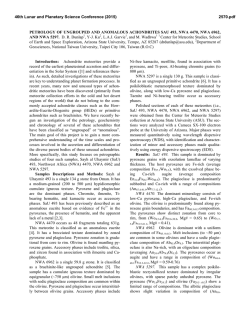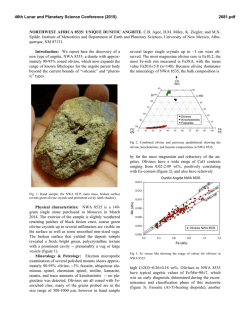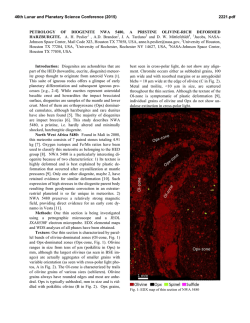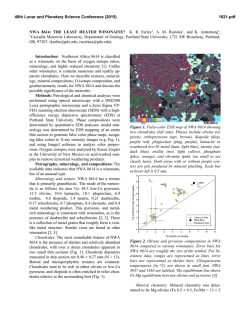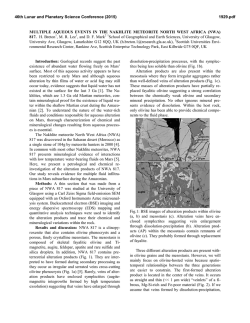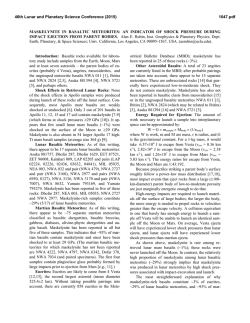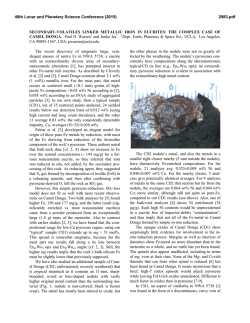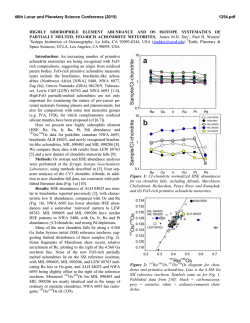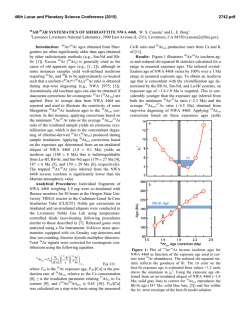
2523 - USRA
46th Lunar and Planetary Science Conference (2015) 2523.pdf MINERALOGY, PETROLOGY AND GEOCHRONOLOGY OF INTERMEDIATE SHERGOTTITE NWA 7042. M. R. M. Izawa1*, K. T. Tait1, D. E. Moser2, I. R. Barker2, B. C. Hyde1, I. Nicklin1, T. J. Lapen3 1 Department of Natural History, Mineralogy, Royal Ontario Museum, Toronto, Ontario M5S 2C6, Canada; 2Dept. Earth Sciences, University of Western Ontario, 1151 Richmond St., London, ON, Canada N6A 5B7 3Dept. of Earth & Environmental Sciences, University of Houston, TX, USA.USA *[email protected] Introduction: NWA 7042 has previously been described as a missing link among the shergottites [1] due to its intermediate trace element composition. We have begun a systematic study of NWA 7042 using electron-beam and laser based microanalysis. Our aim is to provide a more complete understanding of this potentially informative martian sample, and in particular to gain new insights into magmatic processes, crustal and mantle reservoirs, and the timing of igneous and (shock) metamorphic events that affected NWA 7042. Results and Discussion: NWA 7042 consists of zoned olivine, zoned clinopyroxene, with interstitial plagioclase laths (optically isotropic), with accessory Mg-rich merrillite, and traces of Fe-sulphides (likely pyrrhotite), ilmenite, chromite, baddeleyite, and pervasive terrestrial weathering veins consisting dominantly of calcite with barite-celestite. Olivine: Olivine crystals are blocky and subhedral, and commonly have fayalitic rims (Fa46.0-48.1) surrounding more Mg-rich cores (Fa28.5-30.1) [1]. Most olivine crystals contain conspicuous cores with a ‘rusty’ brown appearance in transmitted light. The rims and cores are optically continuous (Fig 1A-B). At high magnification (Fig 1C-D), the cores of NWA 7042 olivines are riddled with inclusions. While it is tempting to ascribe the rusted appearance of olivine to terrestrial weathering, this interpretation is at odds with the higher Mg-number of the olivine cores vs. rims. It is possible that Fe-oxyhydroxide-bearing terrestrial weathering products are precipitating or collecting in a preexisting feature of the olivine cores. At high magnification, the cores appear to have abundant minute inclusions; however, this is not apparent in either BSE or EDS images. The origin of this texture remains enigmatic. Pyroxene: NWA 7042 pyroxenes all exhibit inclined extinction, and occur as elongate euhedral crystals reaching several mm in longest dimension. Many display a sharp optical contact between cores and rims. Chemically, the rims of NWA 7042 clinopyroxene grains are Ca-rich, compared the complexly-zoned cores (Fig. 2) Maskelynite: All plagioclase observed in NWA 7042 is optically isotropic. Preservation of grain shapes, lack of flow textures, and preservation of igneous sector zoning all favor a solid-state amorphization mechanism, and we therefore apply the term maskelynite. Maskelynite occurs in clusters of elongate laths interstitial and generally parallel to clinopyroxene (Fig. 2). In some restricted areas, there is evidence for melting of plagioclase, including the formation of SiO2-K2O-rich glass, resorbed grain boundaries, and reaction textures. Figure 1: Olivine in NWA 7042 with enigmatic ‘rusty’ cores riddled with minute inclusions. The origin of this texture does not appear to be simple terrestrial weathering. Figure 2: False-colour image, EDS element maps overlaid on BSE, showing the general petrographic textures of NWA 7042, red=Mg, green=Fe, blue=Si. Note the strong zoning in olivine grains (red cores with light green-yellow rims), and zoning in clinopyroxene laths. Maskelynitized plagioclase forms clusters of interstitial and parallel to the clinopyroxene crystals. 46th Lunar and Planetary Science Conference (2015) Phosphates: Merrillite is interpreted as the primary igneous phosphate in NWA 7042. Merrillite is always observed in association with plagioclase (maskelynite). In some regions the merrillite is partially, or in rare cases, entirely converted to Cl-bearing apatite (Fig. 3A). Apatite replacing merrillite is commonly associated with textural and compositional evidence of melting, including apparent flow features, and optically isotropic SiO2-K2O-rich material (Fig 3B), interpreted as melt glass. This assemblage should enable trace element and isotopic dating tests to constrain the extent to which shock-related melting has disturbed the chemical and temporal record of martian igneous processes in NWA 7042. Figure 3: A) False colour image, EDS element maps overlaid on BSE, red=Mg green=Cl blue=P. Merrillite (blue) is associated with maskelynite (dark green). B) False colour image, EDS element maps overlaid on BSE, red=Na green=Cl blue=Si. This image highlights the local replacement of merrillite (red-brown) by chlorapatite (green). The replacement of merrillite with chlorapatite is associated with evidence for melting and decomposition, particularly the presence of an SiO2-K2O-rich amorphous material interpreted as a melt glass, some of this material is visible as irregular black patches in the maskelynite. C) Cathodoluminescence imaging reveals sector zoning in maskelynite and shows SiO2-K2O-rich melt pockets, commonly associated with the replacement of primary merrillite by chlorapatite. D) Enlarged CL image of a melt pocket (bright) with zoned maskelynite and merrillite locally replaced by chlorapatite. Baddeleyite: NWA 7042 baddeleyite crystals are typically smaller than 10 μm in longest dimension and appear to retain primary igneous textures, and are not associated with either shock melt pockets (SiO2K2O-rich glassy material) or shock veins. Baddeleyite is sometimes associated with ilmenite or sulphides. 2523.pdf Shock veins: NWA 0742 contains many shock veins which cross-cut the primary igneous minerals (Fig. 4). Evidence for melting within the veins includes flow textures, rounding of entrained clastic material, and micron-scale quench crystallites (likely Fe-Ti oxides). Many primary igneous minerals near shock veins show evidence of thermal alteration near the contacts with vein material. Several characteristics of the veins, including evidence for heating and melting of host rock near the margins, flow features, entrainment of host rock clasts are similar to pseudotachylite. Figure 4: Launch-generated shock veins in NWA 7042 showing evidence for thermal alteration of host rock mineral grains, flow, and entrainment of clastic material. Terrestrial Weathering: Evidence of terrestrial weathering is pervasive, including calcite and barite within fractures and in veins, but concentrated around the exterior of the meteorite. Conclusions: NWA 7042 is dominated by primary igneous signatures with some impact metamorphic overprint. The textural relations between primary (merrillite) and postcrystallization-disturbed phosphates present an opportunity to constrain the timing and geochemical signatures of both crystallization and impact metamorphism. References: [1] A. J. Irving et al. (2012) Lunar Planet. Sci. #2496
© Copyright 2026

